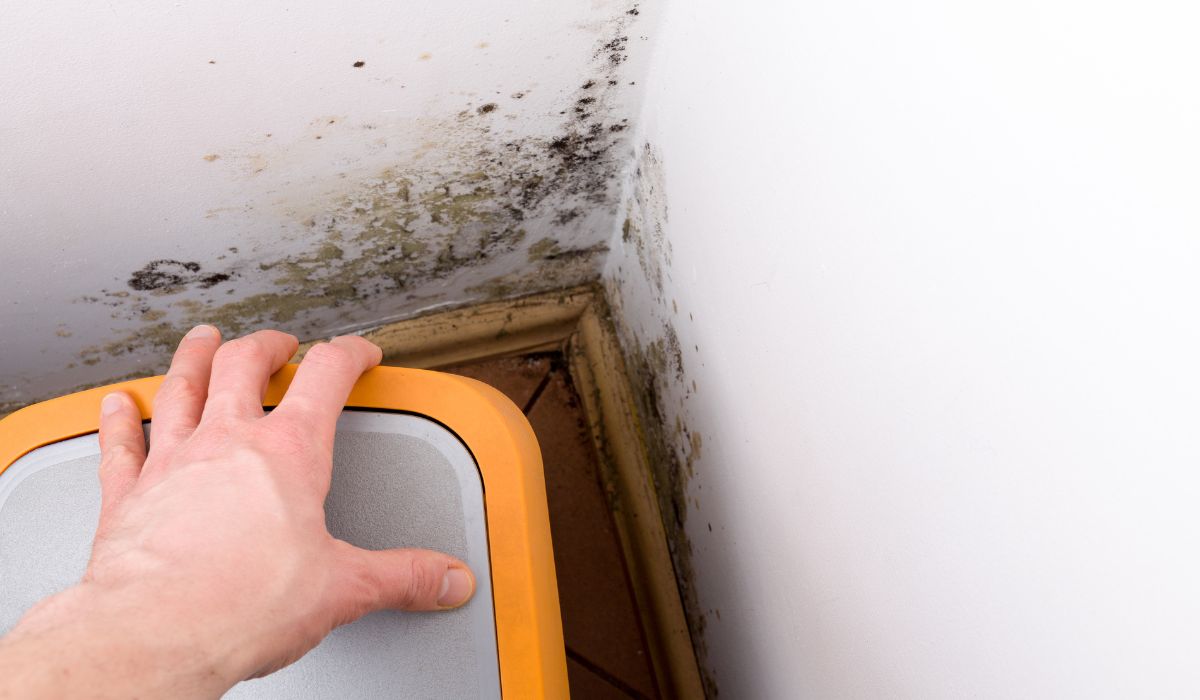Why Does Orange County’s Climate Cause More Mold?
Mold is a common problem many Orange County homeowners face. While this sunny Southern California area has beautiful weather, its climate also creates the perfect environment for mold growth. Between warm temperatures, humidity, and poor ventilation, homes can quickly develop indoor mold problems that lead to health risks and property damage.
In this article, we’ll explore why Orange County’s climate causes more mold, the most common areas it grows, and what homeowners can do to prevent it.

What Makes Orange County’s Climate Ideal for Mold?
Orange County’s mild, coastal weather is known for its warm days and cool nights. But these conditions also create moisture and humidity—two key ingredients for mold to grow.
1. Warm Temperatures Year-Round
Mold thrives in warm environments. Since Orange County rarely gets cold enough to kill mold spores, they can survive and grow throughout the year. Homes in cities like Irvine, Anaheim, and Costa Mesa often stay around 70–80°F indoors, which is perfect for mold growth.
2. High Humidity and Coastal Air
The humidity levels in Orange County are often between 60–70%. That’s just enough to let mold spores settle on damp surfaces like wood, drywall, and attic insulation. Even if you don’t notice it, small amounts of condensation can collect behind walls, under floors, or inside your air conditioning system.
3. Ocean Moisture and Coastal Breezes
While the beach breeze feels refreshing, it also carries moisture inland. Homes closer to the coast—like Newport Beach, Laguna Niguel, or Huntington Beach—absorb salty air that adds dampness to attics, basements, and bathrooms.
4. Seasonal Rain and Drainage Issues
Though Orange County doesn’t get much rain, heavy winter storms can cause flooding and leaks. Poor drainage or roof damage can trap water in walls and crawl spaces, where mold begins to grow within 24–48 hours.
How Humidity and Poor Ventilation Lead to Indoor Mold
Most homes in Orange County are built for comfort, but many have poor ventilation, which traps humid air inside.
1. Bathrooms and Showers
Bathrooms without proper ventilation are one of the biggest sources of indoor mold. Hot showers create condensation that sticks to walls, ceilings, and grout. Without a fan or open window, the moisture can linger for hours.
2. Attics and Roof Leaks
Attic mold is another common issue. When airflow is blocked, heat and humidity build up under the roof. Combined with a small leak or poor insulation, this leads to mold growth on wood beams, insulation, and drywall.
3. Basements and Crawl Spaces
While basements are less common in Orange County, some older homes have them—and they’re a perfect spot for moisture buildup. Floods, leaky pipes, or poor drainage can lead to water damage and black mold growth in dark, damp areas.
Signs of Mold Growth in Orange County Homes
Knowing the signs of mold early can save you money and protect your health. Watch for these common warning signs:
- Musty odor or earthy smell
- Dark spots or discoloration on walls or ceilings
- Peeling paint or drywall
- Allergic reactions like sneezing, coughing, or asthma symptoms
- Condensation on windows or air conditioning vents
- Damp carpets or warped wood flooring
If you notice these signs, it’s time to schedule a professional inspection.
The Health Risks of Mold Exposure
Mold isn’t just a property issue—it’s a health concern. Long-term exposure to mold spores can cause breathing problems and trigger allergies.
1. Allergies and Asthma
People with asthma or allergies are especially sensitive to indoor mold. Breathing in mold spores can cause coughing, wheezing, runny nose, and skin irritation.
2. Black Mold Dangers
Black mold (Stachybotrys chartarum) is one of the most dangerous types. It can release toxins that affect the lungs, nervous system, and immune health. Black mold often forms in areas with water damage, such as under bathroom floors or behind drywall.
3. Vulnerable Populations
Infants, elderly adults, and people with weakened immune systems face higher risks from mold exposure. That’s why homeowners should act quickly if they suspect a problem.

Where Mold Grows Most in Orange County Homes
Mold can grow almost anywhere there’s moisture, but some areas are more vulnerable due to climate and building design.
1. Bathrooms
Hot showers and poor airflow make bathrooms the top spot for mold growth. Check around tile grout, behind toilets, and under sinks.
2. Attics
Attic mold often starts when ventilation is poor or roof leaks go unnoticed. Regular inspections can prevent costly damage.
3. Kitchens
Cooking produces steam that adds humidity to the air. Without good ventilation, mold may grow behind cabinets or near dishwashers.
4. Basements and Crawl Spaces
Even small floods or plumbing leaks can cause mold spores to multiply in these dark, enclosed spaces.
5. HVAC Systems
Your air conditioning unit can spread mold spores through your home if the coils or ducts become damp. Always change filters and have your system cleaned regularly.
How Homeowners Can Prevent Mold Growth
While you can’t change Orange County’s climate, you can protect your home with these simple prevention tips.
1. Control Indoor Humidity
Keep humidity levels below 50%. Use a dehumidifier in damp areas like bathrooms, attics, and basements.
2. Improve Ventilation
Install exhaust fans in bathrooms and kitchens to keep airflow steady. Open windows when possible to let fresh air in.
3. Fix Leaks Immediately
Whether it’s a roof leak, plumbing issue, or flood, repair it quickly. Even a small drip can lead to mold growth within days.
4. Maintain Drainage
Ensure that your drainage system directs rainwater away from your home. Poor drainage can lead to water damage and mold near foundations.
5. Regular Inspections
Schedule professional mold inspections once or twice a year, especially after heavy rain or flooding. Early detection prevents major damage and health issues.
The Role of Climate in Mold Damage
Orange County’s heat and humidity make mold a year-round issue. During summer, air conditioning can cause condensation in vents and drywall. In winter, rain and cooler nights create damp conditions perfect for mold spores to grow.
Because homeowners can’t control the climate, managing indoor moisture is key. Keeping your home dry, clean, and well-ventilated will reduce your risk of mold damage.
When to Call a Professional Mold Inspection Service
If you notice persistent odor, visible mold, or unexplained health symptoms, it’s time to call a mold remediation expert. Professionals can test air quality, identify hidden mold growth, and use safe removal methods to protect your property.
They also use dehumidifiers, fans, and moisture meters to restore your home to safe humidity levels. Choosing a trusted restoration company in Orange County ensures the job is done right.
Why Orange County Homeowners Should Take Mold Seriously
Ignoring mold growth can lead to long-term damage and expensive repairs. Mold weakens wood, ruins drywall, and reduces indoor air quality. It can also hurt your home’s resale value and insurance coverage.
Because Orange County’s climate naturally promotes mold, every homeowner should make prevention part of their maintenance plan.

FAQs About Mold and Orange County’s Climate
1. Why does mold grow faster in Orange County?
Mold grows faster in Orange County because the climate stays warm and humid year-round. Coastal moisture, poor ventilation, and occasional rain create perfect conditions for mold spores to grow indoors.
2. How can I tell if I have hidden mold?
Look for musty odor, peeling paint, or drywall damage. A professional inspection can detect mold behind walls, in attics, or inside air conditioning ducts.
3. What areas in my home are most at risk?
Bathrooms, attics, basements, and kitchens are most at risk due to high humidity and poor ventilation. Regular cleaning and airflow help prevent problems.
4. Can mold make me sick?
Yes. Breathing in mold spores can trigger asthma, allergies, or sinus infections. Black mold can even release toxins that cause more serious health problems.
5. How can I prevent mold growth in Orange County?
Keep humidity low, fix leaks fast, and improve ventilation in damp areas. Use a dehumidifier and schedule yearly inspections to protect your home.
Final Thoughts
Orange County’s warm, coastal climate makes it a wonderful place to live—but also a prime location for mold growth. By controlling humidity, maintaining airflow, and addressing water damage quickly, homeowners can protect their homes and families from mold-related health and property issues.
If you suspect a problem, don’t wait—schedule a mold inspection today to keep your home safe and healthy.



